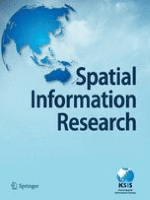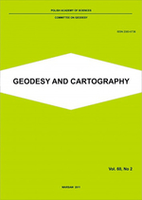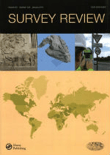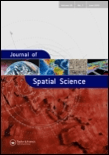
Geodetski List
Scope & Guideline
Exploring the Frontiers of Earth and Planetary Sciences
Introduction
Aims and Scopes
- Geodesy and Surveying Techniques:
The journal covers a wide range of topics related to geodesy, including traditional surveying methods, GNSS applications, and the latest advancements in measurement technologies. - Geoinformatics and Data Processing:
Research on geoinformatics, encompassing data collection, processing, and analysis techniques, is a core focus, particularly in relation to spatial data infrastructures and geographic information systems (GIS). - Cartographic Innovations and Applications:
The journal emphasizes innovative cartographic practices, including digital mapping, remote sensing, and the integration of artificial intelligence in cartography. - Environmental Monitoring and Management:
Studies addressing environmental aspects, including land cover mapping, urban dynamics, and sustainable development through geospatial analysis, are significant themes. - Historical and Cultural Geography:
The journal also explores historical cartographic sources and their relevance in contemporary geographic studies, contributing to the understanding of cultural landscapes.
Trending and Emerging
- Artificial Intelligence in Geospatial Analysis:
The application of AI technologies, including machine learning and ChatGPT, in geospatial analysis and cartography is increasingly prominent, showcasing innovative solutions for data processing and visualization. - Remote Sensing Applications:
There is a growing emphasis on remote sensing techniques for environmental monitoring, urban planning, and resource management, driven by advancements in satellite imagery and data analysis. - 3D Modeling and Digital Twins:
Emerging interest in 3D modeling techniques and the concept of digital twins reflects the need for more accurate representations of physical spaces for planning and management. - Sustainable Development through Geospatial Solutions:
Research focused on sustainability, particularly in relation to marine and terrestrial ecosystems, is on the rise as global challenges necessitate informed decision-making based on geospatial data. - Integration of Geospatial Technologies in Education:
An increasing trend in integrating geospatial technologies into educational curricula highlights the importance of preparing the next generation of geospatial professionals.
Declining or Waning
- Traditional Cadastral Surveys:
Research focusing on traditional cadastral surveys seems to be decreasing as digital mapping and automated data collection technologies gain prominence in land administration. - Analog Mapping Techniques:
There is a noticeable decline in publications regarding analog mapping methods, indicating a shift towards digital and automated approaches that enhance accuracy and efficiency. - Historical Mapping Methods:
While historical cartography remains relevant, the frequency of papers specifically addressing traditional historical mapping techniques has reduced, possibly due to a greater focus on modern applications. - Static Geospatial Models:
The exploration of static geospatial models is waning as dynamic and real-time data processing techniques become more critical in geospatial analysis. - Localized Geospatial Studies:
There is a trend away from localized studies that do not incorporate broader, global perspectives or technological advancements, reflecting a growing interest in comprehensive, data-driven research.
Similar Journals

South African Journal of Geomatics
Connecting Scholars and Professionals in GeomaticsSouth African Journal of Geomatics is a pivotal platform dedicated to the advancement of geomatics, focusing on the dynamic intersection of geographic information science, surveying, and mapping technologies. Published by CONSAS CONFERENCE, the journal serves as a crucial resource for researchers, professionals, and students in the geomatics field, providing insightful, peer-reviewed articles that explore contemporary challenges and innovations. Operating under an open-access model, the journal ensures the wide dissemination of knowledge, promoting collaboration and scholarly exchange among the global geomatics community. With a commitment to enhancing the visibility of significant research and fostering academic discourse, the South African Journal of Geomatics plays a vital role in contributing to the development of this essential discipline in South Africa and beyond.

Spatial Information Research
Exploring the intersection of geography and technology.Spatial Information Research, published by SPRINGER SINGAPORE PTE LTD, is a prominent journal committed to advancing the interdisciplinary field of spatial information science. With an ISSN of 2366-3286 and an E-ISSN of 2366-3294, this journal serves as a crucial platform for disseminating research findings from 2016 to 2024, focusing on applications in Artificial Intelligence, Computer Science Applications, and Geography, among others. Ranking in the Q2 and Q3 quartiles across various categories, it showcases impactful research that informs geographic planning, environmental sciences, and computational methodologies. The journal's rigorous peer-review process ensures high-quality contributions that offer insights for both academic scholars and industry professionals. While retaining exclusive access options, Spatial Information Research is a vital resource for researchers eager to explore the complexities of spatial data and its applications in real-world scenarios.

Journal of Spatial Information Science
Shaping the Future of Geography and Computer ScienceThe Journal of Spatial Information Science is a premier open-access journal published by the University of Maine, dedicated to advancing research in the interdisciplinary fields of spatial information science, geography, and computer science. With an ISSN of 1948-660X, this journal has established itself as a significant contributor to the academic community since its inception in 2010, achieving notable rankings as evidenced by its classification in the Q2 quartile across multiple categories, including Computers in Earth Sciences and Geography. The journal offers a platform for innovative research, fostering collaboration and knowledge dissemination among researchers and practitioners. Its impact is further underscored by its Scopus rankings, placing it in the top percentiles across critical disciplines. With Open Access options available, the Journal of Spatial Information Science ensures that high-quality research is accessible to a broader audience, promoting the ongoing development of the field through thoughtful and rigorous academic inquiry.

Geodetski Vestnik
Bridging Gaps in Earth Sciences through Open Knowledge.Geodetski Vestnik is a prominent open-access journal published by the Association of Surveyors Slovenia, dedicated to advancing the field of Earth and Planetary Sciences. With an ISSN of 0351-0271 and an E-ISSN of 1581-1328, this journal has been contributing valuable research since its inception in 1992, with converged years extending to 2024. As of 2023, it holds a Q3 category in Earth and Planetary Sciences and ranks #144 out of 195 in its Scopus category, indicating a focused, though emerging, presence in the scientific community. The journal embraces a commitment to open access since 2003, ensuring that research is freely accessible to professionals, researchers, and students worldwide. Geodetski Vestnik serves as a vital platform for disseminating innovative research, methodological advancements, and significant case studies in geodesy and related sciences, fostering collaboration and knowledge sharing among scholars and practitioners in Slovenia and beyond.

ISPRS International Journal of Geo-Information
Advancing geospatial understanding for a better tomorrow.ISPRS International Journal of Geo-Information, published by MDPI, stands at the forefront of the field of geospatial sciences, contributing valuable knowledge and research insights since its inception in 2012. This open access journal, which boasts an impressive collection of articles that emphasize the integration of geographic information systems (GIS) in Earth and planetary sciences, currently achieves a remarkable standing, with a 2023 impact factor ranking in the Q1 category for both Earth and Planetary Sciences and Geography, Planning and Development. Researchers and professionals engaged in the study of spatial data, remote sensing, and innovative geoinformation technologies will find the journal an essential resource, offering diverse perspectives and methodologies. With its open access model, the journal aims to promote the dissemination of knowledge globally, fostering collaboration among scholars while pushing the boundaries of research in geoinformation disciplines. The journal is based in Switzerland and is well-positioned to contribute significantly to the understanding and application of geospatial data for societal advancements.

Geodesy and Cartography
Transforming Spatial Data into Insightful SolutionsGeodesy and Cartography, published by the Polska Akademia Nauk (Polish Academy of Sciences), is a premier open-access journal dedicated to advancing the fields of geodesy, cartography, and geographic information science. Since its inception in 2010, the journal has provided a vital platform for researchers, professionals, and students to share their findings, fostering innovation and collaboration in these critical areas of study. With its ISSN 2080-6736 and E-ISSN 2300-2581, the journal is accessible to a global audience, ensuring that cutting-edge research is readily available to enhance scientific understanding and application. The journal not only serves as a repository of knowledge but also aims to contribute to the development of best practices and methodologies within geospatial sciences, making it an essential resource for anyone invested in the ever-evolving landscape of mapping and spatial data analysis.

SURVEY REVIEW
Bridging Academia and Industry with Essential ResearchSURVEY REVIEW is a distinguished journal published by Taylor & Francis Ltd, focusing on a diverse range of disciplines including Civil and Structural Engineering, Computers in Earth Sciences, and Earth and Planetary Sciences. With an ISSN of 0039-6265 and an E-ISSN of 1752-2706, this journal has been a vital resource for scholarly communication since its inception in 1963. Positioned within the Q2 and Q3 quartile categories according to the latest rankings, it is recognized for its significant contributions to advancing knowledge in multiple fields, specifically holding a rank of 64/159 in Earth and Planetary Sciences and 32/73 in Computers in Earth Sciences. Researchers, professionals, and students benefit from its critical insights into complex engineering and scientific challenges. Although SURVEY REVIEW is not open access, it remains a highly cited journal, making it an essential avenue for disseminating pivotal findings that impact both academia and industry practices.

Revue Internationale de Geomatique
Connecting Disciplines Through Geospatial InnovationRevue Internationale de Geomatique (ISSN: 1260-5875, E-ISSN: 2116-7060) is a prestigious journal published by TECH SCIENCE PRESS, dedicated to advancing the field of geomatics. This journal serves as a vital platform for disseminating significant research findings, cutting-edge methodologies, and innovative applications within the realm of spatial data and technology. With an emphasis on interdisciplinary studies, it fosters collaboration among researchers, professionals, and students across various domains, including environmental science, urban planning, and geographic information systems (GIS). Although not an open-access journal, Revue Internationale de Geomatique maintains a rigorous peer-review process ensuring the publication of high-quality articles that contribute to the evolving landscape of geomatics. Given its relevance and commitment to scholarly excellence, this journal is a crucial resource for advancing knowledge and practices in the ever-growing field of spatial information science.

Journal of Spatial Science
Bridging Disciplines Through Spatial AnalysisThe Journal of Spatial Science, published by Taylor & Francis Ltd, serves as a prominent platform for the dissemination of research in the interdisciplinary fields of geography, atmospheric science, and energy. With an ISSN of 1449-8596 and an E-ISSN of 1836-5655, this journal has established itself as a vital resource since its inception in 2004, boasting an impressive convergence period extending to 2024. Recognized in the Q3 quartile for Atmospheric Science and Energy (miscellaneous), and achieving a Q2 classification in Geography, Planning and Development in 2023, the journal not only reflects the evolving complexities of spatial science but also underscores its increasing relevance in addressing contemporary global challenges. The journal holds a commendable position in Scopus rankings, with notable placements in various categories, further highlighting its academic significance. Researchers, professionals, and students are encouraged to engage with the rich content offered, as the Journal of Spatial Science remains committed to advancing knowledge and fostering discussions pertinent to spatial analysis and its applications.

Boletim de Ciencias Geodesicas
Exploring New Horizons in Geodesy and Planetary StudiesBoletim de Ciências Geodésicas is an esteemed academic journal published by the Universidade Federal do Paraná within its Centro Politécnico. Focused on the dynamic field of Earth and Planetary Sciences, this Open Access journal has been a pivotal resource since 1997, fostering the dissemination of critical research and innovative methodologies. With an impact factor indicative of its relevance in the discipline, Boletim de Ciências Geodésicas ranks in the Q3 quartile for Earth and Planetary Sciences as of 2023, showcasing its commitment to quality scholarship in a competitive field. Researchers and students alike will benefit from access to cutting-edge findings, given its broad scope that encompasses various aspects of geodesy and related sciences. The journal's convergence of research from 2005 to 2024 ensures that it remains at the forefront of emerging trends and fundamental developments in the discipline, further enhancing its esteemed reputation in the academic community.